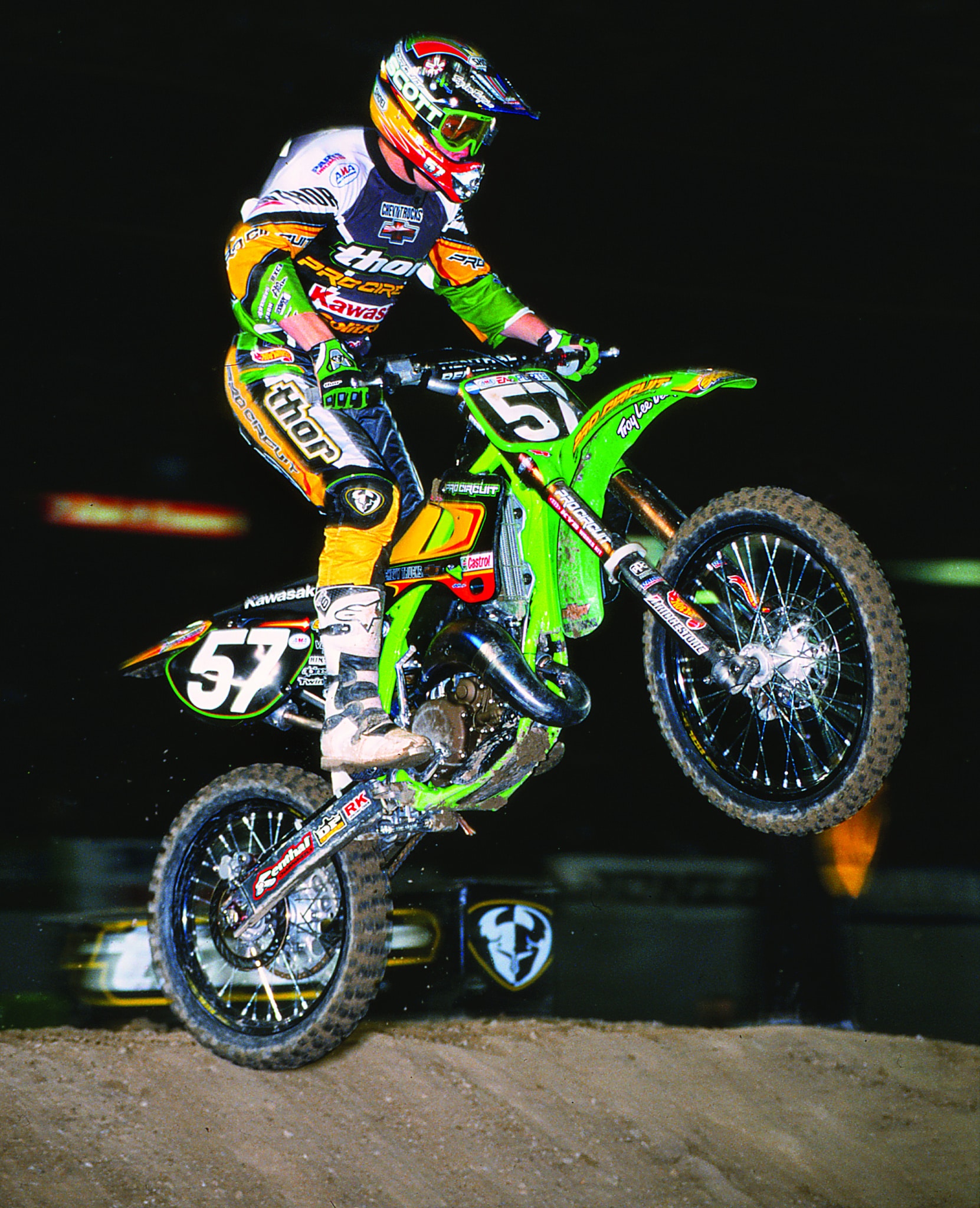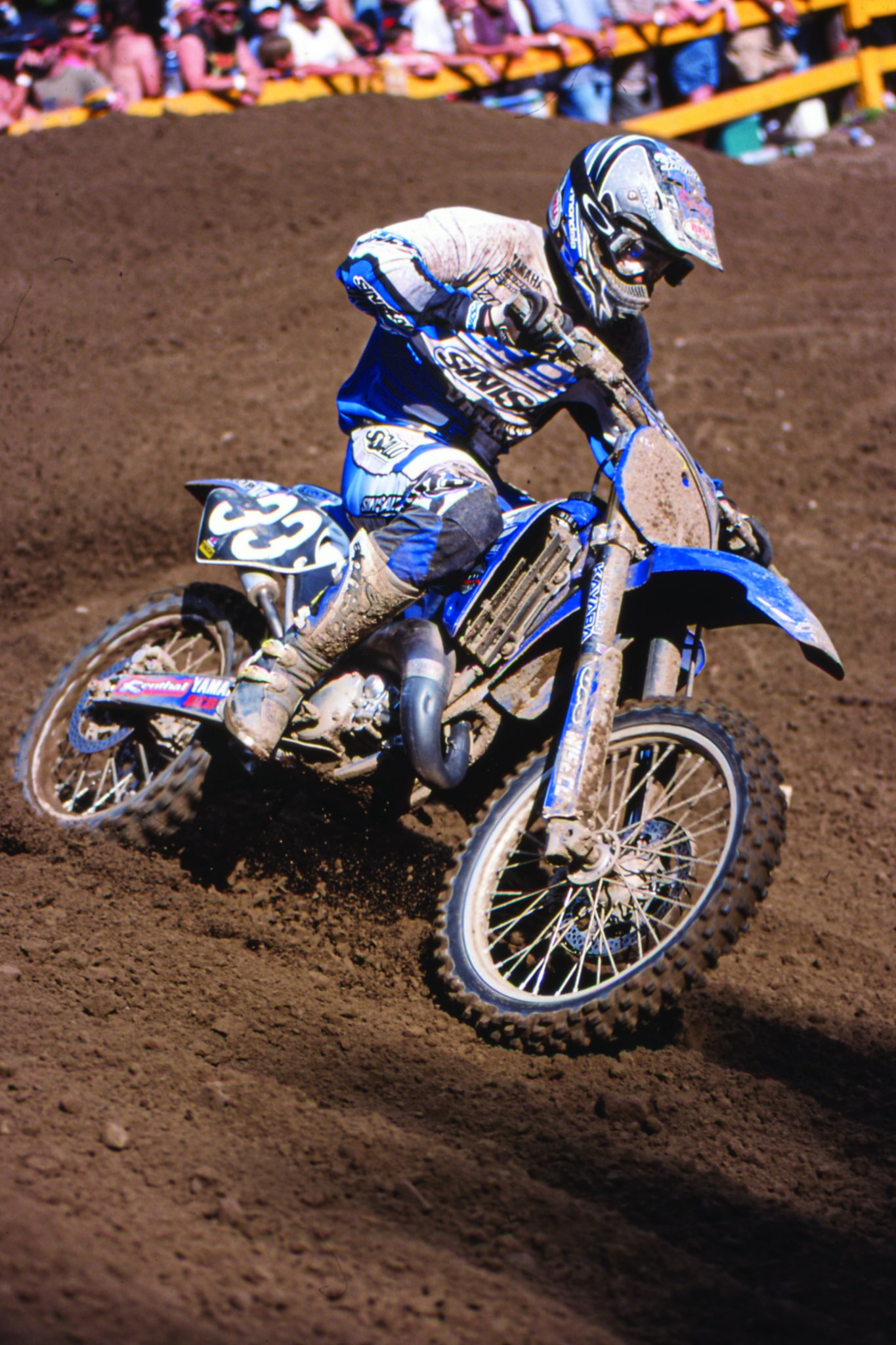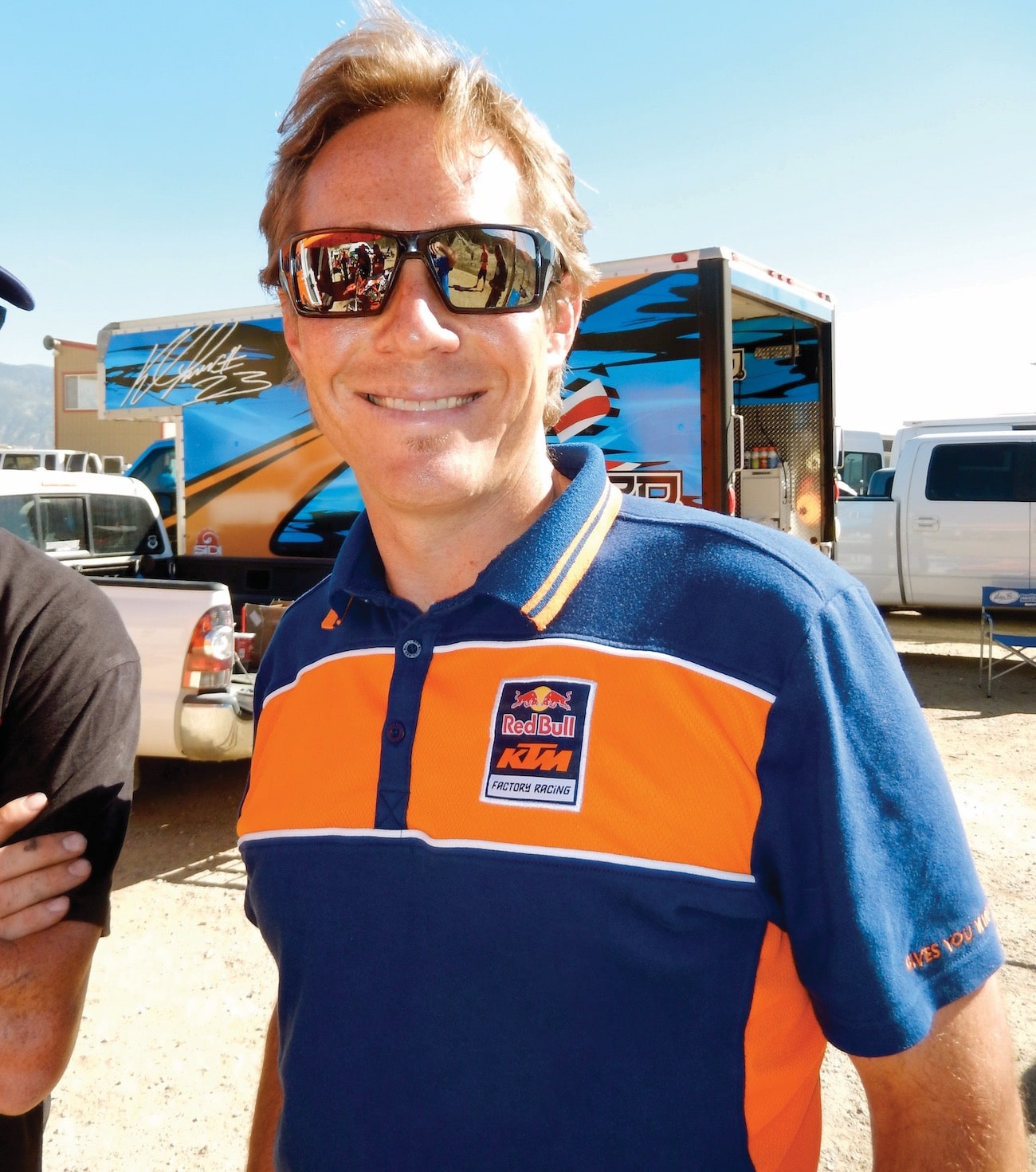MXA INTERVIEW: CASEY LYTLE HAS SEEN BOTH SIDES NOW

BY JIM KIMBALL
CASEY, DID YOU GET INTO MOTORCYCLES BECAUSE YOUR DAD WORKED AT HONDA? Yes, my dad started at Honda in 1982. He had a Honda before that, but that is when we really started getting more bikes as a family. We had a large backyard, so the first bike was an XR80. That was big for me, but the other kids in the family could ride it. Then my dad ended up getting me a Z50. I have three brothers and one sister, so we had a large family. We used to go off-road riding, and that turned into racing. At one point, everybody in the family raced, except for my mom, but I was the only one who stuck with it.
WAS IT CLEAR FROM EARLY ON THAT YOU HAD NATURAL TALENT? When I raced on 80s, the highest level I ever got to was 80 Novice. Shortly after that, I stepped away from racing for six months. When I came back, I raced the 125 Beginner class and got moved up that day to 125 Novice. I was a Novice for about a year. Then I was an Intermediate, and two years later I turned Pro. I only did Loretta’s twice. I had one Loretta’s Championship in the 250 B class in 1995.
“ON THE LAST LAP, THE GUY IN FRONT OF ME ONLY DOUBLED AND I TRIPLED. I LANDED IN THE WHOOP SECTION AND ENDED UP BREAKING MY ARM, BUT I STILL GOT FIFTH.”
YOU RACED THE 1996 AMA 125 WEST SUPERCROSS ON A PRIVATEER BIKE? That was with Honda of Troy. I would buy bikes through Honda of Troy and pay them off with my Honda contingency money. I was a senior in high school and did three Supercrosses and three Nationals in 1996. At my very first Supercross, I got 14th. My second race was the San Diego Supercross, and I got a good start. I forget who I was racing with, but on the last lap the guy in front of me only doubled and I tripled. I landed in the whoop section and ended up breaking my arm, but I still got fifth. Later in the year, I came back for the Denver Supercross and finished seventh.
WERE YOU A JUMPER? Where I grew up, our house was against the hills, and we had the last house on the street. Every day after school, I would come home and go riding behind the house. Eric Kehoe, Damon Huffman and Mike Kiedrowski practiced there. It had big cliff jumps and big road jumps. I grew up jumping, and it was very normal for me.
 Casey with his three-digit number on Honda of Troy in 1997.
Casey with his three-digit number on Honda of Troy in 1997.
WHEN DID YOU GET NOTICED? In 1997 I got my first podium at Dallas in the mud for Honda of Troy. It was Windham, Reynard and then me. I didn’t consider myself to be a mud rider. In 1998 I switched to the 125 East, and I struggled with the ruts going up the face of triples, but I got a couple of podiums and finished fifth overall in the 125 East.
IN 1999 HONDA OF TROY BECAME YAMAHA OF TROY. I was teammates with Casey Johnson in the 125 West. I had a good year. That 1999 YZ125 was awesome. I felt that there was nothing that YZ125 couldn’t jump. That was my mindset going in, but I could never put it together in 1999 for a win. I felt I was confident, but in the middle of the races, I would fall apart every time. I would start thinking, “Somebody is catching me.” Nate Ramsey was tough that year. I had five second-place finishes, a third, a fourth and a fifth. I ended up losing the 125 West Championship by 6 points to Ramsey at the last round.
“I FELT I WAS CONFIDENT, BUT IN THE MIDDLE OF THE RACES, I WOULD FALL APART. I WOULD START THINKING, ‘SOMEBODY IS CATCHING ME.’ I ENDED UP LOSING THE 125 WEST CHAMPIONSHIP BY 6 POINTS TO NATHAN RAMSEY AT THE LAST ROUND.”
IN 2000 YOU MOVED TO FMF HONDA AND GOT YOUR FIRST WIN. The CR125s handled well that year, but they were never as good as the Yamahas. It was a bit of a struggle, because I had to start the CR125 in first gear to get off the line (I started in second gear on the YZ125). I had confidence in myself and believed that I should be winning. At Phoenix I got my one and only 125 Supercross win and was on the podium with eventual 2000 125 West Champion Shae Bentley and 2002 125 West Champion Travis Preston.
BUT THINGS SEEMED TO FALL APART IN 2001. Yes, I had signed with Mitch Payton for 2001 but struggled with little injuries, and, looking back, there was a lack of focus on my part. I started overthinking everything. I felt like I should be up front, but I couldn’t get it together. It was a tough year and not fun. Mitch was tough, and I would say rightfully so. Looking back on it, I think a team manager must put a little pressure on the guys to get the most out of them. He was rightfully hard on me to perform; after all, I was hired to perform, and I was not performing.
 Casey won the Phoenix 125 West Supercross on his FMF Honda in 2000.
Casey won the Phoenix 125 West Supercross on his FMF Honda in 2000.
YOU WENT BACK TO YAMAHA FOR 2002? Yes, for 2002 I was going to race the new Yamaha YZ250F four-stroke. I was getting used to the bike and gradually doing all the jumps at the test track when I came up short. I ended up breaking my right wrist and my left arm. I did come back and get a fourth at Anaheim in 2002 and felt like I was going to find my way back to the front, but I never really got back to where I should have been.
AND 2003? The following year I was not sure what I really wanted to do. I got a job working at car auctions and was still trying to race. I was out of shape. Lots of times I would go to work at the auction early in the morning and then try to ride in the afternoon. When I got to the races, I did not have enough stamina to be competitive. I raced my way into a little better shape, but had to miss races because I couldn’t afford to go to them.
IS THAT WHEN KTM APPROACHED YOU? Shortly after the 2003 Supercross season, Larry Brooks called. He was the KTM team manager, and they were looking for a test rider for the race team. They offered me a decent salary. I was struggling to make ends meet, and it was enticing to go there and have something a little more stable. I started at KTM in August of 2003 as the KTM race team test rider.
“AT THAT POINT, IT WAS A BIT OF A RELIEF, BECAUSE I FELT IT HAD BEEN SUCH A STRUGGLE THE PREVIOUS COUPLE OF YEARS. GOING TO WORK AT KTM GAVE ME A SENSE OF RELIEF.”
WHAT DO YOU WISH YOU HAD DONE DIFFERENTLY IN YOUR RACING CAREER? Where I went wrong, looking back after some years, is that I should have put a lot more into it. I was training, but I feel like there was more that I could have done. In the years that I struggled, maybe a sports psychologist would have been a major help for me, because mentally I would always question myself. I had good results, but I never felt like I belonged there, except for the one win. For whatever reason, that night in Phoenix I was completely confident and knew that I was going to win. Struggling in 2001 at Pro Circuit Kawasaki knocked me back more, and I should have buckled down and focused harder, but I did not do enough.
WAS IT DIFFICULT TO GIVE UP RACING? At that point, it was a bit of a relief, because I felt it had been such a struggle the previous couple of years. Going to work at KTM gave me a sense of security and a sense of relief that maybe this was my logical next step. At KTM, I was mainly a test rider, but they also said I could be a fill-in rider if someone were injured. That was the case at Anaheim in 2004. I raced for KTM and ended up breaking my wrist.
 Casey was second in the 125 West by 6 points to Nathan Ramsey in 1999.
Casey was second in the 125 West by 6 points to Nathan Ramsey in 1999.
WHAT WERE THE FIRST RACE TEAM PROJECTS THAT YOU WORKED ON? It was the 125 two-stroke. I also did a fair bit of 250 two-stroke testing when Grant Langston was racing the 250SX. We spent a lot of time with the electronic power valve on the KTM for Grant. But, mostly we worked on getting the suspension better.
THAT WAS WHEN KTM HAD PDS SUSPENSION ON THE MOTOCROSS BIKES. WHAT WAS PDS LIKE? I feel it worked well. There were times when Nathan Ramsey was making passes in the whoops for the lead. It was easy for the public and riders to blame PDS if things weren’t going well, but KTM still stands behind PDS on the EXCs and XC-Ws to this day. I know it works well.
WERE YOU SHOCKED TO BE NAMED KTM TEAM MANAGER IN 2007? Larry Brooks announced in 2007 that he was leaving KTM. I wasn’t actually named the team manager then; I became the Team Coordinator under team manager Kurt Nicoll. Kurt was spending a lot of time traveling back and forth between Austria and the U.S. races. At that point, it was scary because I did not have a lot of managerial experience, but I managed to get through it in no small part because Kurt guided me. I did that for a couple of years until KTM cut back during the 2008 recession and we farmed the team out to MDK. I stayed on as liaison between KTM and MDK and even became the West Coast customer service manager for some time.
 Casey was on the Pro Circuit Kawasaki team in 2001.
Casey was on the Pro Circuit Kawasaki team in 2001.
IT MUST HAVE LOOKED GRIM DURING THE RECESSION. Not behind the scenes. From an R&D standpoint, KTM was busy developing new bikes, and they moved me out of customer service back to being the team manager for the race team, which was Tommy Searle and Mike Alessi. That was when the 350SXF came out, and Mike raced it during the outdoors. It was a great bike, and it continues to be an excellent bike. I think from a racing standpoint, it would take someone mentally tough to be racing a 350 in the Pro class when everyone else is on a 450. When Roger DeCoster and Ian Harrison came on board, I moved back over to Race Team Coordinator. I worked there for a couple of years under Roger, and then I moved over to the R&D department.
“THE MOVE TO BRING OVER ROGER WAS ONE OF THE BEST MOVES THEY COULD HAVE MADE. I KNOW MYSELF THAT I HAVE LEARNED A LOT FROM ROGER AND IAN. THE RESULTS SPEAK FOR THEMSELVES.”
KTM HAS HAD A MAJOR IMPACT ON THE SPORT SINCE THEY GOT ROGER. The move to bring over Roger was one of the best moves they could have made. I know myself that I have learned a lot from Roger and Ian. The results speak for themselves. When KTM first got aggressive with R&D and came out with the 350, the next step was bringing Roger and Ian over. Then getting Dungey on the bike was next. To see what KTM has accomplished in a relatively short period of time has been amazing.
 Casey got his start at Honda of Troy and stayed with them when they became Yamaha of Troy.
Casey got his start at Honda of Troy and stayed with them when they became Yamaha of Troy.
DO YOU FOCUS ON PRODUCTION BIKES OR RACE TEAM BIKES? Mostly production, although we work with the race team as far as working early with them on bikes they will be racing the next year. They must agree with the changes, too, because they have to race production bikes. Overall, I oversee off-road bikes and some on-road stuff. We do suspension and durability. There are eight of us in the R&D group. We also do development and settings for WP aftermarket suspension, which includes the Japanese brands. We do production suspension for the SX and XC model lineup, and we also do minibike testing.
HOW HAS KTM KEPT ITS BIKES SO LIGHT? Several years ago they decided they were going to analyze every part of the bike. They went through and shaved weight on every little detail. We were lighter with electric start than the Japanese brands were without it. People initially laughed at electric start on a motocross bike. No other brand did it. Now, several years later, almost everybody has followed KTM’s lead.
WHAT IS THE BEST PART ABOUT YOUR JOB? We have a great group of guys right now. I enjoy getting to work with motorcycles and having a good team around me. Everybody in our group, all the way up to CEO John Hinz, is a motorcycle enthusiast.
WILL YOU BE A LIFER AT KTM LIKE YOUR FATHER WAS AT HONDA? I love what I do. I see no reason to ever leave KTM. It is a great organization, and everyone is a motorcycle enthusiast. It’s difficult to say what the future holds, but I have no reason to go anywhere. This is home.







Comments are closed.